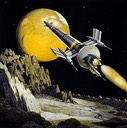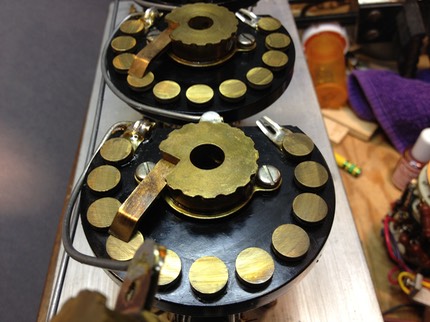I'm working on a General Radio type 602-J decade resistance box. I should have remembered Conrad Hoffman's admonition to not use solvents to clean up the front panel, but I forgot and used hi-test isopropyl alcohol. This dulled the gloss on the paint. Oh, well, I'll try using some wax to get the gloss back.
One of the decade switches was very hard to turn due to old grease that had turned to glue. I had to use a pin punch to get the shaft out to clean it up. I've removed and cleaned up all the switch shafts and contacts and plan to re-lubricate them with petroleum jelly. I'd also like to clean up and re-lubricate the switch hubs, but the bearing looks to be swaged together. The bearing looks like it was originally lubricated with the same grease as the shafts and contacts. I could flush out the grease with solvent, but I can't get the bearing apart to re-grease it. I'm hesitant to use oil instead. Any suggestions - should I just leave the switch hub bearing alone?
Update: I set up a four-wire resistance measurement with my HP 3468A multimeter. The rotating contact on the switch measured between 7 and 9 milliohms as I rotated the wiper. So, clearly no need to remove the old grease; it's working just fine.
Update: I haven't found a manual for the 602-J, but the General Radio Catalog K5 from 1946 does list some of the specs. The zero resistance should be less than 3 milliohms per switch, so it's not quite meeting specification presumably due to the old grease. For the four decades of the 602-J in total, I measure 24 milliohms at zero; the catalog says the maximum zero resistance should be 12 milliohms.
The isopropyl alcohol also removed much of the white paint filling the engraved panel legends. I tried using lacquer stick but it just made a mess; it fills in the cracks in the crackle finish and I can't get that clean without also removing the lacquer from the engraved legends. I'm planning to try some thinned white acrylic paint, applied to the engravings with a fine-point brush and maybe with some photo-flo added to help it wet better, in an attempt to minimize the amount of paint that ends up in the crackle. Anyone have suggestions on how to deal with coloring engraved legends on a crackle or wrinkle finish?
Update: Conrad Hoffman's GR restoration page notes that the legends on GR panels aren't filled but just engraved down to the bare aluminum. I broke out my Hasting triplet 10X magnifier and examined the engraved legends. Sure enough, Conrad was quite correct; they are not filled with pigment, just filled with decades worth of grime on mine. I carefully went over the engravings with a carbide scriber and dug all the crud out. They look great now.
Another update: on second thought, I shouldn't have used a scriber. Instead I should have tried scrubbing the crud out with an old toothbrush and some isopropyl alcohol. Using the scriber risks mutlilating the engraving.
I put on a coat of Butcher's Wax and it really brought back the shine on the crackle finish.
I've lubricated the switch contacts and the detents; now I just have to lubricate and replace the shafts and clean and polish the knobs.
I haven't found a manual for the GR 602's, but there is an issue of the GR Experimenter that examines their frequency response.
The solid walnut case is finished with shellac and has a few dings and bare spots. I'll get to learn french polishing on this piece. I'm starting to develop quite an attraction to old General Radio instruments; they have a real quality feel to them.
Calibration update:
I checked it out using my HP 3468A in four-wire resistance mode. Except for the zero resistance problem noted above, the unit is still well within its specification limts of 0.25% on the units decade and 0.1% on the remaining decades, as shown on the linked spreadsheet.












